The Future According To 1981: An 'Omni' Appreciation
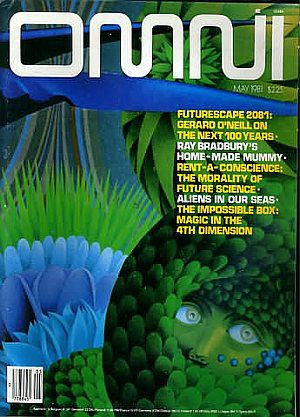
In May of 1981, a draft-dodging ex-pat American published his first story in Omni magazine. The event went largely unremarked. After all, Ronald Reagan was just a few months in office then, and that was either awesome or terrible, depending on your viewpoint, plus that was the same month the Pope got shot! Which is why we now have a Popemobile! But there at your local newsstand, or, if you were lucky (or your parents were generous), there in your mailbox in the plain brown wrapper, William Gibson’s “Johnny Mnemonic” saw print.
And as you may have heard, the Internet Archive has done the world a service by maintaining an online archive of the complete print run of Omni, the beloved science magazine that had a glorious two-decade run from 1978 to 1998. So why not let’s give one particular issue, that Omni May 1981 issue with its Gibson story, a bit of a reread, as it’s just sitting there asking for it. Omni was a magazine about the future. The future is here. Let’s look forward from thirty some years ago.
DEAR PENTHOUSE FORUM, YOU WON’T BELIEVE THIS… BUT UFOS!
At some point, and I reckon this was more towards the middle of high school, I realized that the layout of Omni resembled that of another magazine — Penthouse. There was a reason for that. Omni, launched in 1978, was the brainchild of Kathy Keeton. Keeton, was a South African, trained in ballet, who, in her 20s, became an exotic dancer in Europe (an AP story would later say she’d been one of the highest-paid strippers on the Continent). She met a young Bob Guccione when he noticed her reading the Financial Times between sets. Together they launched their intended competitor to Playboy, Penthouse. Keeton also wanted to start a magazine that was not just a science-fiction magazine, but also a science magazine. Prior to that, sci fi, even though written by men and women with science backgrounds, was often relegated to a more juvenile audience, and even though there was a viable conversation to be had between sci fi and science, that was a marriage the publishing industry had yet to arrange. Speaking of which, Keeton was also the long-time companion (and later wife) of Guccione. Hence, “Editor [later, Editor-in-Chief] and Design Director Bob Guccione” appears at the top of the masthead above the table-of-contents for the run of the magazine. So, why did Omni look like a nudie magazine without any nudes? Because its creator was a former burlesque star/nudie mag executive, and its design director was the second most successful nudie magazine publisher ever. (By the way, Omni went web-only for its last few years, so Keeton was a groundbreaker in more ways than one. She died in 1997, and the website followed her a year later.)
Conveniently, the FIRST WORD section, an editor’s note to start things off, contains something of a mission statement for Omni. It’s written by Executive Editor Ben Bova, a science fiction eminence who started out at Omni as Fiction Editor (after editing Analog for seven years prior to that), and it’s a defense of science fiction as a sort of a strain-testing of science:
Here at Omni, science fiction has been an integral part of our editorial “mix” from the very beginning. Because Omni is “the magazine of tomorrow,” our aim is to examine the future in every way that we can, with feature articles columns of subjects as diverse as television and astronomy, interviews of the world’s leading thinkers — and with science fiction. In fact, science fiction allows us to present dimensions of the future that cannot be seen in any other way.
Bova left the magazine less than a year later. But don’t let’s think that a measure of the quality of this particular issue!
For an 138-page magazine, it is a fat packet of information, with 27 items listed in the table of contents (which do not include the single-panel comics sprinkled throughout). Actually, since the archivists chose to mostly omit full-page ads, we can deduce that it’s a little less than 87 pages of content.
The front of the book alone is a monstrous amount of info, and we haven’t even gotten to the features yet. It’s divided into categories, each a monthly column, with all-caps headings: EARTH, SPACE, LIFE, THE ARTS, EXPLORATIONS and (my favorite) UFO UPDATE. In this issue, there’s a history of the College of the Atlantic, an examination of changes to the human body after extended stays in zero-G environments, a look at the groupthink psychology of U.S. presidential administrations, and more. These are some heady topics to be tackling when the writers could all have been home watching “Dallas.”
The UFO UPDATE in this issue is a little dry, about phenomena in the People’s Republic of China…

… but this installment of THE ARTS is terrific, a profile of up-and-coming director David Cronenberg. “Some part of me would love to make a movie of William Burrough’s Naked Lunch,” says Cronenberg in the lead paragraph. Ominous.
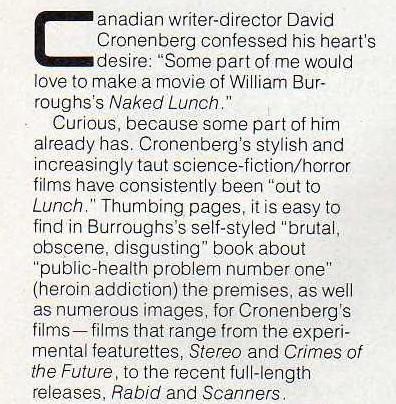
And then this is followed by CONTINUUM, which is the brief-items section, which was also my favorite section, as it was perfectly tailored to my twelve-year-old attention span and appropriately whimsical. Kind of like “That’s Incredible!” Six whole pages of newslets or factoids or whatever you call them: Didja know that the NTSB found a correlation between the whistling of pilots and airplane crashes? Didja know that someone developed a cocoa-based toothpaste? Didja know that Stanford Research Institute posited that WWIII would be fought with computers and not missiles? (Good one, that.) Some of these items are blips, press releases that never made it to proof-of-concept (like the wristwatch rape-prevention device), but still dripping in novelty.
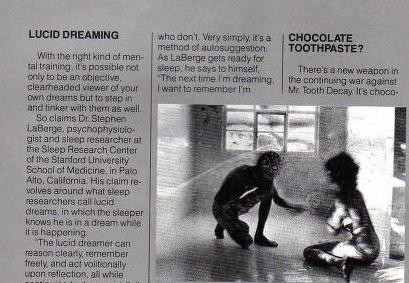
HOW CLOSE ARE WE TO THOSE 2081 PREDICTIONS?

Wading into the features, there’s an essay by Gerard K. O’Neill entitled “2081,” on “five emerging technologies and their impact on society.” It’s not quite 2081 yet, but 32 years seems a safe perspective to see if O’Neill’s predictions are trending in the right direction. O’Neill passed away in 1992 at the age of 65, after a seven-year fight with leukemia. Before that, he was a hard-science futurist from back before futurists were cool. A radar technician in the Navy, he got his doctorate in physics from Cornell and then basically birthed colliding-beam studies, like the CERN particle accelerator that we worry might accidentally create a black hole. He was the founder of the Space Studies Institute, a vocal proponent of space colonization. After he died, Freeman Dyson compared him to Richard Feynman, which is pretty high company.
The five emerging technologies, the “drivers of change,” are computers, automation, space colonies, communications and energy. He nails an amazing amount of it; his predictions on space colonies, though, remain doomed to a more-distant future. (Although there’s still 68 years until his 2081 deadline, and there are certainly some smart/dedicated/wealthy people working on it.) His idea for sustainable energy are interesting — a combination of satellite solar energy, microwaved to earth-bound stations, and thorium “slow” reactors. Of course, those are still both as futuristic now as they were then.
On the remaining three (computers, automation and communications), O’Neill was well on the mark. “Long before 2081 it will be possible to store in a machine the size of a business card all the information of a good sized library,” he writes. What he missed, of course, is that that machine will also be able to communicate with the rest of the world and control the automations in the factories. But the thing about emerging technologies is that they pay no heed to boundaries, and have no compunction against merging with neighboring technologies or morphing in to an entirely new one.
But who knows? Perhaps if O’Neill hadn’t died when he did, I’d be writing this in a slow-reactor powered space station a couple million miles outside the gravity well.
ASK A PROFESSIONAL ETHICIST
The provocatively titled “Rent-A-Conscience,” by Douglas Colligan, concerns the birth of professional ethicists. Colligan identified the two think tanks at the time that were weighing in on the ethical quandaries of the day, such as the first test-tube baby (which caused quite a ruckus at the time) and the right-to-die of Karen Ann Quinlan. “A few years ago, ethical think tanks were dismissed as ivory-tower toys for bored philosophers. But now ethicists are a force.” Prescient! And now even more so, in a world of genetically modified everything and retail gene sequencing.
And even yet more. There’s a charming profile of Jerry Andrus, perhaps the most ethical magician who ever lived, which manages to debunk “mystery spots” as a by-the-way, a story on NASA’s program to put student science experiments on the space shuttle, an in-depth if not wonky interview with Olaf Helmer, the coinventor of the Delphi method, a social forecasting technique that was integral to the nascent field of futurism, and even a bit on the relative intelligence of octopi.
And the images. There are a number of stunning illustrations and photographs: splashes for a feature or short story, a Phenomena photo of autumn clouds (the viewing of which to be improved by a hypnodisc, which you are to cut out and spin on your turntable), the extraterrestrial-vehicle-paintings of Vincent Di Fate, and a pictorial of the spectral photography of Dale Eldred, who is, we were informed obsessed by time. “Not abstract Einsteinian time, but ancient temporal measurement.” Science is never too far away, even in Guccione’s splashy design.
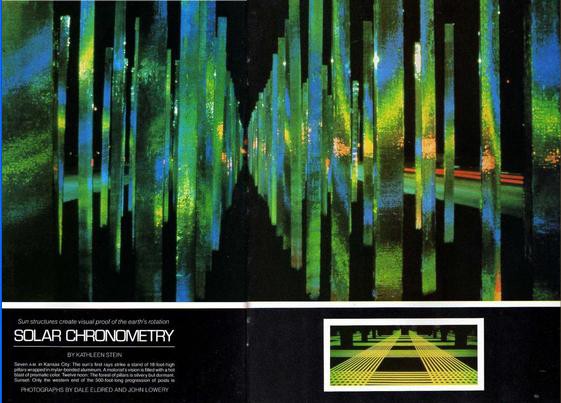
Even the games column, written by Scot Morris, is deliberately braniac, as he devotes a couple hundred words to the history of minimum-information images, landing on Dali’s “Lincoln in Dalivision and the issues surrounding it. The game? Send in your best stab at a minimum information image, readers, and the winner gets a hundred bucks. (The two runners-up get $25 apiece.)
“I’M JOHNNY,” I SAID
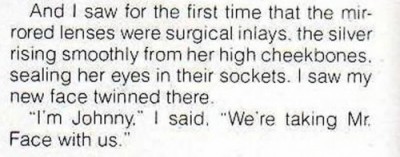
But of course, the appeal of Omni at the time (or at least in our memory), is the short fiction that ran, amidst all the science journalism. And this particular issue, maybe a collector’s item for Gibson’s “Johnny Mnemonic,” is actually a very useful snapshot of the forces that were tugging science fiction towards the next century.
The author’s name that appears on the cover is not Gibson; it is Ray Bradbury, who needs no introduction. Bradbury contributes a very very Bradbury story, “Colonel Stonesteel’s Genuine Home-Made Truly Egyptian Mummy.” A lyrical (of course) little affair, a young boy and an older feller in a small Illinois town fighting the “desperate empties” of a slow summer day with a touch of mischief. There’s not much science to this one, nor really any element of the fantastic, other than the prose of Bradbury. It is wistful and nostalgic for a time when bored boys staved off stultification by throwing rocks at the windows of haunted houses. And in fact, it could pass as Bradbury’s secret origin, as the boy, Charlie, tells the Colonel during the sighing final moments of the story: “I made up my mind. I’m going to be the greatest writer that ever lived.”
And if that was not enough of a nod to history, on pages 126 and 127 there’s a “Science Fiction Table of Elements,” with each of the then-103 elements designated as a widely-known science fiction writer of the time.

You’re tempted to think that it’s actually ranked hierarchically, as hydrogen is Robert Heinlein and helium is Harlan Ellison, but by the time you get to sodium (Curt Siodmak), you see that it’s more a play on the chemical symbols than anything. But pre-Wikipedia, I’ll bet that a list of 103 science fiction writers would be a majestic thing to which to discover on the next page.
Back to Gibson. He’s not featured on the Table of Elements. On the CONTRIBUTORS page, Gibson is described as “a full-time writer living in Vancouver, British Columbia,” which I’ll bet felt nice to see in print. “Johnny Mnemonic” is prototypical early Gibson, all big ideas and sentences you could cut your finger on, set in an urban dystopia that is impossible not to imagine as the set of “Blade Runner.” It was the dawn of the cyberpunk aesthetic, and “Mnemonic” is as noir as they come, hard-boiled “I dare ya.”
As a fan of both Bradbury and Gibson, it’s nice to revisit these stories in situ, because the conversation they have with each other is the interesting thing. Bradbury’s was set in the past but was aware of the (then) present:
“What do you see out there in the damn town?” the Colonel asked. “Any murders being transacted?”
“Heck, no — “
“Anyone falling off church steeples or being run down by maniac lawn mowers?”
“Nope”
Bradbury is going to write the story he damn well pleases, and if an elbow to Stephen King’s ribs is what it takes to get those kids off his lawn, so be it.
But “Mnemonic,” even though dealing in intentionally nostalgic tropes, is looking solidly somewhere over the horizon:
“…We’re an information economy. They teach you that in school. What they don’t tell you is that it’s impossible to move, to live, to operate at any level without leaving traces, bits, seemingly meaningless fragments of information.”
We may not (yet) live in a world with a leather-pants assassin with mirrored lenses implanted over her eye sockets, or junkie dolphins with super-conducting quantum interference detectors in their brains, but Gibson gets it right. In the margins, in the shadowy edges of the story, where there’s no running or killing or anything, but he gets it right.
Not that Bradbury doesn’t also get it right. But if this particular issue of Omni is a stage, then the opening act just became a tough act to follow
PREDICTION: IN THE FUTURE, EVERYONE WILL BE HARDER TO PLEASE
The Last Word column was written by professional debunker James Randi, who is still with us, in which he hands out his Uri Awards, named after the Isreali magician who convinced the world that he could bend spoons, for instances of gullibility with regards to claims of paranormal science. Think of it a listicle. That year’s winners included the TV show “That’s Incredible!”, notable for its trade in “psychics” with wild “abilities”; Isaac Bashevis Singer, for claiming that he believes in ghosts and dybbuks; and Ronald Reagan for famously claiming to consult with astrologers. Remember astrologers?
It’s an Amazing Randi good read, a shot of grappa to ease digestion, even though I am a staunch proponent of the paranormal, in the interests of keeping the world weird. Which reminds me of something in the profile of the ethical magician Jerry Andrus in the same issue, where the writer notes:
But pure magic, the magic that looks like a real miracle, Andrus-style, is in a strange way antithetical to new technology. As society becomes more technologically sophisticated, we, as an audience, become more suspicious and harder to please.
That’s certainly true now too (and I suspect it was true thirty years before that issue of Omni). But there’s a lot to chew on in this 32-year-old artifact of magazine publishing. Some of it may be outdated, but Omni was a convenient vehicle for understanding the present by trying to figure out what happens next. Who could have predicted how much we’d miss it.
Related: A Timeline Of Future Events
